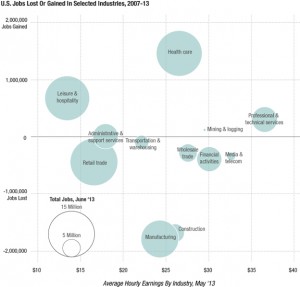
A few years ago, I visited classrooms filled with poor and working class students in a diverse high school in Texas; I was launching a long-term study on teenage social life that formed the basis for my book Fitting In, Standing Out. Because I was the first professor that many had ever met, the students grilled me about what it took to go to college, and I responded by asking them many questions about their future plans. In addition to the fact that, apparently, all teenagers now want to be forensic investigators, one thing that struck me was just how uniform their college expectations were. Every kid, regardless of background, wanted to go to college. Few had a concrete idea of how to make that happen.
This mixture of hope, ambition, and, for lack of a better word, cluelessness that I saw crystallized for me how higher education can simultaneously reduce and fuel inequality in the U.S. The truth is that college-going has become more important than ever, but it is also an often murky process that puts a premium on many factors beyond academic merit. In this process, youth from low socioeconomic status (SES) families are at a distinct disadvantage. Unlike their better-off peers, they could not count on their parents and grandparents setting up college funds or using their connections to get them into the best schools and programs.
Critically discussing today’s push toward college is important. Much like the “Just Say No” anti-drug campaign of the 1980s was criticized for being simplistic and unrealistic, “Just Go to College” is too facile a response to many of the problems of inequality the U.S. faces as it emerges from the depths of the Great Recession. We need to go beyond bromides to understand the challenges involved in getting into, going to, graduating from, and paying for college, and we need plans to address each step. Because each of these challenges reflects socioeconomic disadvantages passed down across generations, the success of efforts to support the children in poor and working class families might very well rest on what we can do to help their parents.College Matters
A college degree meant more for me in the long run than it did for my parents, and it will likely mean much more for my children than for me. Although the recent onslaught of news stories about college graduates going straight to the unemployment line creates the perception that this upsurge in the value of a college degree has taken a hit during the Great Recession, that perception is false. A variety of historical trends explain why.

Historically, the U.S. economy was based in manufacturing. As a result, the labor market was shaped like a pyramid, with a small supply of high-value, high-demand occupations requiring special training at the top. Then came a large supply of stable, non-professional jobs with benefits that required only a high school diploma in the middle. These jobs allowed Americans to gain a secure economic foothold and sponsor the social mobility of the next generation. In the classic example, poor parents who work in a menial job (at the wide base of the pyramid) would send their children into the public K-12 system. Those children would then use their high school education to land jobs on an auto assembly line (in the middle of pyramid), thereby providing the resources for their own children to go to college, start a business, and/or become professionals. If all went well, the third generation could top the pyramid.
Since the late 1960s, however, the economy has shifted into an information/service phase—Apple has replaced GM, as it were. New kinds of skills are sought and rewarded. The resulting hourglass-shaped labor market has a broad stratum of well-paying high-skilled jobs at its top and even broader stratum of insecure low-skilled jobs at the bottom, with very little in between. Higher education has become the most effective way to push through the bottleneck, dramatically increasing the payoff of making the leap from high school into college. An illustration of these rising “returns” is the earnings premium, or the increased percentage of earnings that comes with a college degree. According to the College Board, the premium was between 20-30% when I was born in the early 1970s but had skyrocketed to well over 65% by the time my children were born in the 2000s.
Thinking of returns solely in terms of money, however, would be a mistake. Going to college brings many other advantages in life—from the durability of marriage to good mental health to life expectancy.
Importantly, sociologists Jenny Brand and Yu Xie have shown that many of the returns on higher education are greater for youth who are least likely to go to college, such as those from socioeconomically disadvantaged backgrounds. This finding makes perfect sense. Yet, as documented by many economists, the increase in American youth attending and graduating from college over the last several decades has come primarily at the upper tails of the socioeconomic distribution. In other words, poor and working class youth have more to gain from going to college but are less likely to do so.Efforts to interrupt the intergenerational cycle of socioeconomic inequality, therefore, must break down the barriers that keep youth from lower-SES backgrounds from realizing the opportunities for social mobility that college-going represents. These efforts can be informed by understanding how the path to college plays out over long periods of time and is deeply connected to the personal histories and current circumstances of parents.
Recognizing the Obstacles
We’ve known since the famous “Coleman Report”—a 1966 study funded by Congress—that schools serving lower-SES populations have less academic rigor, a worse resource base, and poor instructional quality relative to those serving more socioeconomically advantaged communities. After 13 years of often drastically unequal schooling, students from more poor and working class backgrounds are less prepared to ace the high-stakes tests that weigh so heavily in college admissions, let alone the challenges of college coursework if admitted. What may seem to some like a meritocratic competition (that is, colleges admitting high school seniors based on their academic records) is merely the tail end of a long journey of inequality.One caveat to this pattern is the “frog pond effect”: is it better to be a big frog in a small pond or a small frog in a big pond? When test scores and grades are held constant, a student attending an underprivileged high school is somewhat more likely than a student attending a more competitive high school to be admitted to the college of her or his choice. What needs to be stressed, though, is years of school inequality would mean the former student would be less likely to get to that equivalent academic position than the latter. This dualism of frog pond effects—an apparent exception to and actual example of inequality—has been illustrated for me by the rancor over a policy here in Texas. It grants automatic admission to state flagships for top-ranked graduates of Texas public high schools, regardless of which school. An attempt to promote college-going for students from the most disadvantaged communities in the state, the “Top 10% Plan” has been accused of favoring highly-ranked students at struggling schools over “better” students ranked lower in their classes in more competitive schools.

Another caveat is that the focus on the path to college begins before K-12 schooling. Young children from lower-SES families have less cognitive stimulation and structured learning in and out of the home and are less likely to attend preschool than better-off kids. They enter school with under-developed academic skills, and, although this disparity might reflect learning opportunities more than learning abilities, it sets children on divergent academic trajectories by affecting teacher expectations and curricular positions. As sociologists of education Doris Entwisle, Karl Alexander, and colleagues have illustrated over the years, the cumulative nature of the K-12 system means that even small differences in school readiness can compound into large end-of-school differences. Growing awareness has led to calls for expanding preschool access, calls bolstered by econometric evidence that early interventions bring greater long-term returns to investment than those targeting later stages of schooling.
As important as they are, differences in school quality cannot completely explain socioeconomic disparities in college-going. More interpersonal processes are also at work. Sociologists like Stephen L. Morgan and Annette Lareau have illuminated the subtle ways that students from lower-SES families are at a competitive disadvantage because they know less about what factors go into college admissions and how they are weighted. Unlike their higher-SES peers, their parents cannot finance supplemental supports (for example, tutors and admissions consultants) to demystify the admissions process, nor can they draw on knowledge from their own personal histories and social connections about courses, activities, and other resume entries that different colleges might value.
I once interviewed two motivated girls about their college plans. One from a working class background said that her mother counseled her to better her chances of getting into college by boosting her overall G.P.A. and appearing well-rounded, even if that meant dropping out of advanced math and science classes and replacing them with courses like sign language. The other, a daughter of college graduates, opined that good grades and activities would not mean much absent a rigorous course load; her parents had insisted taking Calculus now would mean that she could place out of it once she got to college. Despite similar abilities, the former student was clearly less well-positioned to get into and stay in the college of her choice than the latter. Such uninformed vs. informed decision-making is a window into how SES is transferred from parent to child. The sociology literature abounds with other examples, such as pushy high-SES parents getting their children into curricula above their abilities, the weight of “legacies” in admissions, and the proactive efforts of to serve students with high-SES parents.Of course, money does matter, and not just through its power to boost school quality and provide supplemental supports. College-going can bring huge financial costs, and students from poor and working class families are often unable to afford the sticker price, not to mention all of the non-tuition expenses, including books, room and board, and more frequent incidental costs, like fast food and coffee purchases. Moreover, youth from such families may not have a good sense of what all of those costs are, and they tend to have less of a handle on financial aid and the other supports that may be available to them, despite being the primary intended recipients.
A Strategy for Side-by-Side Scholars

Many risks that I have covered here are rooted in how much money parents have, and parents’ finances are intricately related to their own educational attainment. Other risks are rooted in differences in the non-monetary advantages that some parents have. These, too, are tied to their educational histories. Given this centrality of parent education to the risk equation, one method of promoting socioeconomic equity in college-going in the U.S. might be to raise the educational attainment of lower-SES parents.
Yes, this idea can be quickly dismissed as both circular and too late in the game. After all, as teenagers approach the transition into college, their parents’ educational careers would seem to be long past done. Yet, research shows that many Americans—especially disadvantaged Americans—accrue education discontinuously, often after becoming parents. Furthermore, evidence is accumulating that parents who return to higher education while their children are still in grade school increase their active management of their children’s education in ways that promote academic progress. In addition to the financial boost that education brings, such parents may learn more about how education works, feel more efficacious dealing with school personnel, be better information-seekers and consumers, and have higher expectations for their kids (after all, if mom is studying in the evening, why wouldn’t she expect her kids to do the same?). Again, these effects are likely to be strongest for the most disadvantaged Americans. This U.S. pattern echoes the two-generation tradition in international aid and development of investing in the education of parents to promote the long-term educational interests of children.
Taking a two-generation approach to socioeconomic disparities in college-going is a long-term strategy. By supporting the school enrollment of socioeconomically disadvantaged parents of young children today, both government and non-profit programs may increase the flow of those children into the college pipeline tomorrow. To date, evidence that such programs (for instance, the recently defunct federal program Even Start) work is mixed, but their current low investment and duration are possible reasons for underperformance. In thinking big about the problem, a long-term strategy is worth a closer look: it aligns well with what we know to be some of the greatest risks facing children from low-SES families on the path to college.
Two-generation investment is a specific idea that is part of a larger need to inject fresh thinking into research and policy intervention. If higher education matters so much in the U.S., then more must be done to even out socioeconomic disparities in college-going—by addressing the financial terms of the equation, yes, but also by targeting the many non-economic mechanisms that keep youth with lower-SES parents from realizing college dreams.At the same time, we also need to start a bit of a tricky conversation: how can we make higher education matter less? In other words, we’ve got to identify viable ways for youth to develop skills and find security in the labor market without going to college. As recent reports about debt loads and dropouts in the burgeoning online college market suggest, we still have more to do to answer this question. Whether children coming of age in the Great Recession are going to end up a lost generation, squeezed by an hourglass economy, depends on what we do now.
Recommended Reading
Paul Attewell, David Lavin, Thurston Domina, and Tania Levey. 2007. Passing the Torch: Does Higher Education for the Disadvantaged Pay Off across the Generations? Russell Sage Foundation. A fascinating study of the educational performance of parents and their children over three decades that demonstrates how promoting socioeconomically disadvantaged youths’ access to higher education can pay off in future generations.
Claudia Goldin and Lawrence Katz. 2008. The Race between Technology and Education. Cambridge, MA: Harvard University Press. An explanation of long-term trends in the U.S. (and global) economy that have dramatically increased the value of going to college.
Eric Grodsky and Erika Jackson. 2010. “Social Stratification in Higher Education.” Teachers College Record 111: 2347–2384. A thorough and thoughtful review on inequality and education, emphasizing institutions as well as students.
Thomas Kane. 1999. The Price of Admission: Rethinking how Americans Pay for College. Washington, DC: Brookings Institution Press. A discussion of why the costs of higher education have risen, the challenges that this rise pose to socioeconomically disadvantaged youth, and the policies and programs that have potential to help.

Comments 2
Friday Roundup: Jan. 24, 2014 » The Editors' Desk — January 24, 2014
[…] “Students Squeezed by an Hourglass Economy,” by Robert Crosnoe. How college is still worth the cost, how those who benefit most are least likely to get a college education, and why decoupling “good” jobs from degrees could help everyone. […]
Students Squeezed by an Hourglass Economy | MemePosts — January 24, 2014
[…] View Original: Students Squeezed by an Hourglass Economy […]